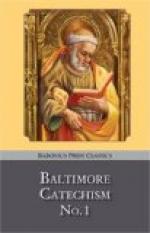(2) The sins, past, present, and future of all men. He knew all things, as we have said, and looking back upon the world He saw all the sins committed, of thought, word, and deed, from the time of Adam down to His own; and seeing all these offenses against His Father, He was very much grieved.
(3) The third reason why He grieved. He looked forward and saw how little many persons would profit by all the sufferings He was about to endure. He saw all the sins that would be committed from the time of His death down to the end of the world. He saw us also sinning with the rest. No wonder then that He suffered so much in the garden. This suffering on that night is called “Our Lord’s Agony in the Garden.” That night Judas, who had betrayed Him to His enemies, came with a great band of soldiers and people, with swords and clubs, to make Our Lord a prisoner. He did not try to escape, but stood waiting for them, though all His Apostles, who had promised to stay with Him, ran away. Then the soldiers led Our Lord to the house of the Chief Priest. Then they gathered the priests, and gave Him a kind of trial, and said He was guilty of death. But at that time the Jews had no power to put persons to death according to the law; so they had to send Our Lord to Pontius Pilate, the Roman Governor, to be condemned, because they were under the power of the Romans. The Jews acted against their laws in the trial of Our Lord.
(1) They tried Him at night; and (2) they allowed Him no witnesses in His defense, but even employed false witnesses to testify against Him, and thus acted against all law and justice. Early in the morning they led Him to Pilate, who commanded that He should be scourged. Then they stripped Our Lord of His garments, fastened His hands to a low stone pillar, and there He was “scourged” by the Roman soldiers. The lashes used by the Romans were made of leather, with pieces of bone, iron, or steel fastened into it, so that every stroke would lay open the flesh. It is most likely these were the lashes used upon Our Lord till every portion of His body was bruised and bleeding, and they replaced His garments upon Him. Now, you know if you put a cloth upon a fresh wound the blood will soak into it and cause it to adhere to the mangled flesh. Our Blessed Lord’s garment, thus saturated with His blood, adhered to His wounded body, and when again removed caused Him unspeakable pain. Next, the soldiers, because Our Lord had said He was a king—meaning a spiritual king—led Him into a large hall and mocked Him. They made a crown of long, sharp thorns, and forced it down upon His brow with a heavy rod or reed; every stroke driving the thorns into His head, and causing the blood to roll down His sacred face. They again took off His garments, and opened anew the painful wounds. Because kings wore purple, they put an old purple garment upon Him, and made Him a mock king, genuflecting in ridicule as they passed before Him. They struck Him in the face and spat




